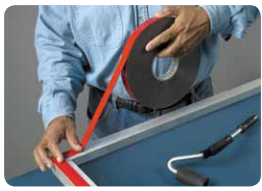
VHB Tape Benefits
There are a wide range of advantages to using VHB tapes over conventional fastening methods. VHB tapes create virtually invisible fastening for a permanent bond. Material options with tapes are also much broader that with mechanical fastener options. Additional benefits include:
- Smoother, more attractive appearance
- High strength, durable bonds
- Vibration and noise dampening
- Flexibility and high expansion
- Seals against moisture
VHB Tape Applications and Industries
VHB tape is used extensively throughout many different applications. The foam tape is used in many bonding applications, both indoor and outdoor. The viscoelastic acrylic VHB foam tape enables a vast range of applications, some of which are listed below:
- Manufacturing and Product Assemblies – Attach components with a secure and stable bond that resists heat, impact, and vibration. No tools are required.
- Commercial Vehicles – Replace screws and rivets that will loosen and vibrate, causing noise and leaks. Create a smooth exterior surface for decal application.
- Electronics – Die cut components fit securely and precisely within devices for a thinner, sleeker finished product. Multiple materials can be joined and the low-profile bonds are shock resistant.
- Appliances – Glass, metal, and plastic components can be securely attached without the need for traditional fasteners that are vulnerable to impact and vibration.
- Signage – VHB tapes provide a smooth surface with a virtually invisible bond, for a sleek, eye-catching sign that will stand up to the elements.
Selecting the Right Foam Tape
VHB tapes from 3M seal, bond, and attach a wide variety of materials: including plastics, glass, and metals. Depending on the requirements, VHB tapes provides an excellent bond to differential materials, with a high tensile strength, conformability and high shear and peel adhesion. A combination of properties and environments to consider are listed below.
- Substrates – Differently surfaces interact with adhesives in unique ways according to their properties and surface energy. Surface should be tested for flow of the adhesive and ability to achieve contact with the other surface.
- Thickness – Choose tapes according to the thickness of the materials involved. Higher thickness foam tapes should be used with materials that have higher rigidity and flatness. Thinner tapes should be used with more flexible material.
- Expansion & Contraction – Tapes can typically tolerate differential movement in the shear plane up to three times their thickness.
- Bond Flexibility – Since tape bonds can be more flexible, applications that require a higher degree of stiffness may need appropriate design modifications.
- Extreme Temperatures – Plan for applications that require performance at extreme temperatures to assure proper adhesion performance.
Surface Preparation for Applying VHB Foam Tapes
To obtain optimum adhesion, the bonding surfaces must be well unified, clean, and dry. Follow the list below for a successful bond.
- Most surface substrates are best prepared by cleaning with a 50/50 mixture of isopropyl alcohol (IPA) and water. Be sure to wipe in one direction.
- Degreasing may be necessary to cut oils where heavy oils or greases are present.
- Abrasion or scuffing of the surface will enhance adhesion for many surfaces by increasing the surface area available for bonding. This process must be followed by cleaning with IPA or water.
- Make sure the surface is completely dry before bonding.
If you think VHB tapes might be right for your project and would like to learn more, contact us to speak with a Can-Do adhesive tape specialist.
